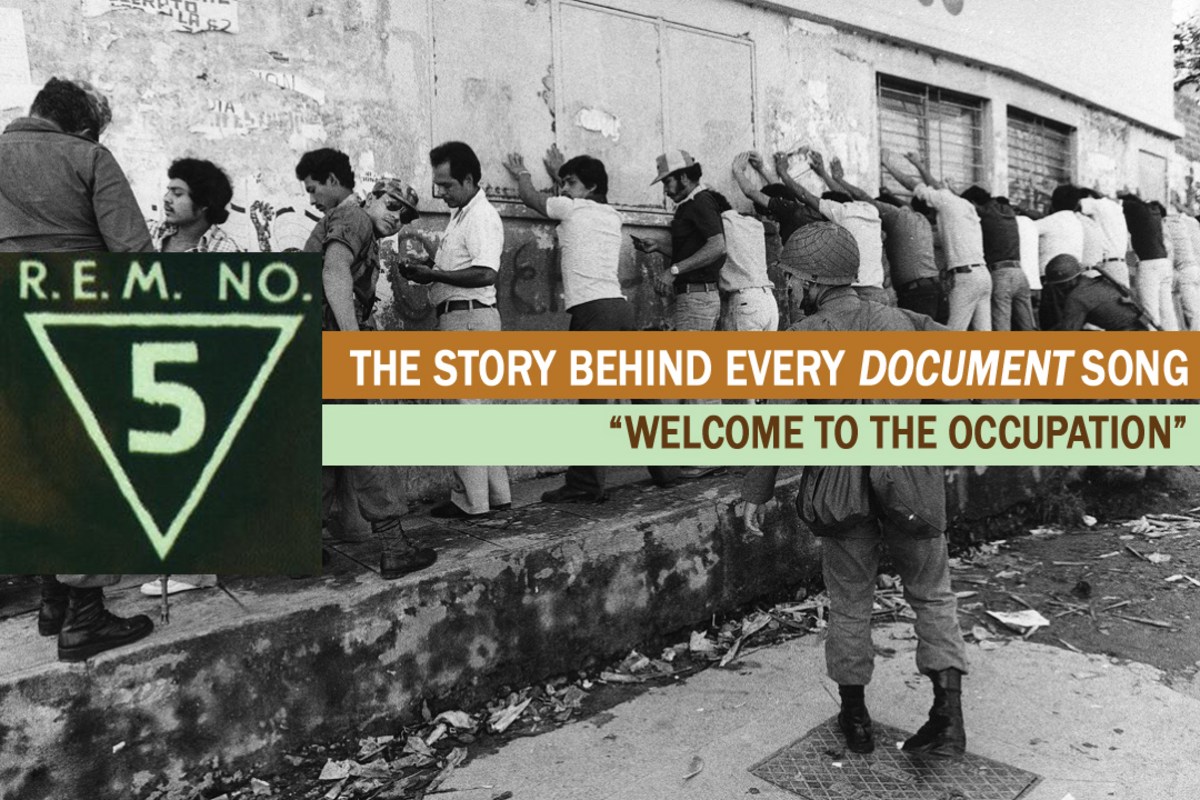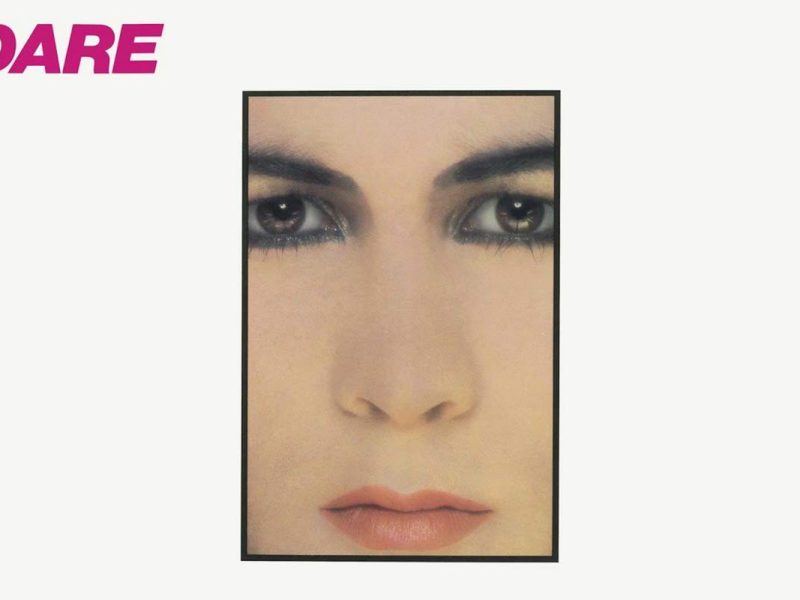“Listen to me.” There’s a moment at the end of “Welcome to the Occupation,” where Michael Stipe repeats this phrase over and over, sounding more pained and exasperated with every reiteration. Is he singing in place of the occupied, pleading with the world to recognize their plight? Or is he playing the role of occupier, imploring those beneath him to follow orders? Or is he just himself, politically conscious R.E.M. frontman, attempting to draw attention to injustice? “Listen to me.”
If the specifics aren’t clear, Stipe’s passion and position on the subject were. “Welcome to the Occupation” was the second track on R.E.M.’s forceful Document album, but it was the third song the singer had written about the United States government’s intervention in South and Central America. He, and his bandmates, had become increasingly disturbed by what they were learning.
Quick history lesson: In the ’80s, during President Ronald Reagan’s administration, the U.S. supported right-wing dictators in El Salvador and Guatemala and secretly funded anti-Communist contra fighters in Nicaragua, all of this under a zero-tolerance policy towards groups with communist leadership. These civil wars – with one side backed by American money, training and weaponry – were violent conflicts that led to the deaths of hundreds of thousands of people. The American-supported, right-wing organizations were responsible for the majority (though not all) of the carnage, including human rights abuses such as the murder, rape and torture of innocent civilians.
“It was a secret little Vietnam we had going on down there and it’s not like we were saving anyone from anything,” R.E.M. guitarist Peter Buck said in 33 Revolutions Per Minute. “It was wrong. It was just plain wrong.”
The band had been compelled by their interest to include songs about these conflicts on consecutive albums. “Green Grow the Rushes,” on 1985’s Fables of the Reconstruction, referenced the U.S.’s economic involvement. “The Flowers of Guatemala,” on 1986’s Lifes Rich Pageant, drew an allegory to the widespread violence by way of lyrics about a toxic flower, or mushroom, which covered the country. R.E.M. thought about including a lyric to make the message less oblique, but decided against it. That would not be the case the next time around.
“I think I got tired of writing a song that had a lot in it and no one could understand,” Stipe later revealed to Q magazine.
So, with “Welcome to the Occupation,” the lyrics became more pointed, though no less poetic. Stipe opens the song with “Hang your collar up inside,” a possible reference to Catholic priests, such as Archbishop Oscar Romero, who decried the military violence in El Salvador and were murdered as a result. The line “Held and dyed and skinned alive” refers to the juntas that meted out “justice” by wielding machetes. A lyric about hanging freedom fighters was seemingly deemed a step too far, and it was changed to “Hang your freedom higher.”
But R.E.M. didn’t shy away from other facets of these conflicts, including implications of colonization, economic combat and environmental destruction. Stipe contrasts the “fed and educated” occupiers with the supposedly “primitive and wild” occupied people, in an echo of past conquistadors. He distinguishes “Sugar cane and coffee cup” (typical Central and South American crops) against “Copper steel and cattle” (classic American exports).
In “Welcome to the Occupation,” the singer repeatedly returns to the concept of fire – a Document theme, hence the LP sleeve’s direction to “File under fire” – in lines such as “Fire on the hemisphere below” and “The forest for the fire.” This seems to refer to the overall vicious nature of the conflicts, but also, in a take on “the forest for the trees,” might make a nod to the environmental disaster happening with the depletion of the rain forests.
Just in case Stipe’s angry tone and distressing imagery could be misconstrued, he made a decision to illuminate his subject matter. In concert, he introduced “Welcome to the Occupation” by referencing the U.S. and El Salvador. He helped the press release promoting Document’s August 1987 release, “so they would say, ‘this is a song about American intervention in Central America’.” The performer, who in the past, had been accused of mumbling his lyrics or making lines up on the fly did not want to be misunderstood any longer.
As Stipe’s singing and lyrical intentions were coming into focus, so was R.E.M.’s sound, which achieved a crisp strength on Document that had not previously been a hallmark of the band’s aesthetic, at least on record. Although Buck’s minor-key twisty tangle and jangle identifies the song as something solidly in the R.E.M. wheelhouse, he also lets his guitar growl a bit, particularly coming out of the instrumental break that leads to the song’s final minute. It’s like his frustration is building along with the track.
If Mike Mills’ bass isn’t as muscular as it is on some of the album’s other tracks – notably those with a funk tinge – it remains propulsive and the bassist is likely also responsible for the warbling organ that wafts in mid-song and grows stronger to underscore Stipe’s “Listen to me” coda.
But it’s the drums that really push “Welcome to the Occupation.” Credit Bill Berry’s steady and sharp playing, as well as those stutter-step transitions, but also Scott Litt’s efforts in his role as co-producer. As R.E.M. and their new collaborator Litt went into Nashville’s Sound Emporium studio in March of ’87, Litt made it a goal to give greater definition to the band’s sound with a focus on Berry’s drums and Stipe’s vocals. On this track, the percussion crackles while the singer declares, decries and wails.
Both Litt and the band were thrilled with the results, with Stipe declaring the partnership “monumental” and the two sides continuing to work together into the late ’90s. The sound of “Welcome to the Occupation” was important, but it all began with Stipe’s approach to a song about weighty issues. Looking back, the frontman describes R.E.M.’s fifth album as an era of significant growth for him as a songwriter, who could create lyrics that “actually f—ing resonated on a very deep level.”
“I began to realize around Document that I had skill and I honed it,” Stipe told The Guardian in 2016. “In time it went from skill to art and my job was to forget everything and allow the instinct to take over, and that’s when the great songs came.”
It’s clear that R.E.M. considers “Welcome to the Occupation” one of their “great songs,” a warning against U.S. intervention that they performed frequently on tours in 1987, ’89, ’95 and in the ’00s during wars in the Middle East. Never released as a single, the song was nevertheless chosen for inclusion on the 2006 compilation And I Feel Fine… The Best of the I.R.S. Years 1982-1987.
Top 100 ’80s Rock Albums
UCR takes a chronological look at the 100 best rock albums of the ’80s.



